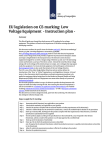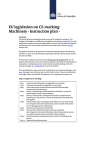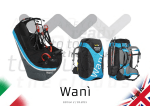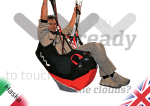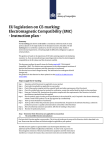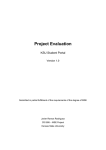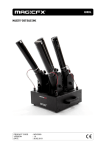Download EU legislation on CE-marking
Transcript
EU legislation on CE-marking: Machinery - Implementation plan Introduction CE marking your product in many cases is not an easy thing to do. Therefore, CBI developed this document that will guide you through the whole process of CE marking machinery. This guidance is based on the experiences of CBI when assisting exporters in developing countries. Â For more information see the related documents: • CE marking Introduction, explaining the basics and used terminology. • CE marking implementation plan, describing the step-by-step approach used in this document as well. This document outlines the specific issues for Directive 98/37/EEC: Machinery (MD). So, if you are manufacturing or exporting machinery to the EU, please read this document carefully. In this document, a number of links have been included, either by text in blue (before the first use of this link), in purple (after the first use of this link) or by showing an arrow “>” or by underlined text. Depending on the settings of your computer, you may get access to the links by one of the following modes: Clicking, Double clicking Pressing [Ctrl] and clicking simultaneously with the mouse (left mouse click) Right mouse click, select “open hyperlink”, left mouse click. If the links do not work, please contact CBI. Steps to apply the CE-marking Step 1 Step 2 Step 3 Step 4 Step 5 Step 6 Step 7 Step 8 Step 9 Step 10 Determine which Directive(s) are applicable to your product Check which standard(s) are applicable to your product Check if the product complies with the essential health and safety requirements of the Directive(s) Check if a notified body must be involved for certification, contact the notified body for details on the procedures Draw up a Technical File, showing how the product complies with the requirements of the Directives, and which specifications (standards) have been applied Test the product (type) according to the specifications in the technical file, and, if required in the relevant Directive(s), submit a model of the product to an EC type approval by a notified body Draw up an EC Declaration of Conformity Draw up a file in which the production process is described and, if required in the relevant Directive(s), submit the production process to a quality control procedure as describes in the Directive(s) After all conformity assessment procedures: affix the CE-marking to the product Monitor the production process Source: CBI Market Information Database • URL: www.cbi.nl • Contact: [email protected] • www.cbi.nl/disclaimer Page 1 of 13 Step 1 - Determine which Directive(s) are applicable to your product Find out which Directive applies to your product. This is done by looking at the scope of the Directive, which is described in its text. Please note that more than one Directive might be applicable to your product. 1.1 The Machinery Directive Directive 98/37/EEC: Machinery applies to two families of products: • Machinery and similar equipment • Safety components Directive 98/37/EEC covers machinery and individually marketed safety components of machinery and lays down essential requirements for health and safety mostly concerning operators and persons near machinery. The essential safety requirements do not directly concern environmental protection or the technological performance of machinery. Some of them can obviously help to ensure these. For example, intrinsic reduction of machinery noise for the operator helps to reduce environmental noise. Â Please note that step 1 requires investigation whether other Directives might be applicable as well. The scope of the Directives reveals if a product is described by the Directive. Some products may be subject to more than one Directive. For example, for electrical machinery the machinery Directive, the Low Voltage Directive (LVD) and the Directive on Electro-Magnetic Compatibility (EMC) are also applicable. If the machinery contains pressure equipment, the Pressure Equipment Directive (PED) may be relevant, and if the machinery is designed for use in a potentially explosive atmosphere, the ATEX Directive requirements must be observed. See the related documents on the various Directives mentioned. To establish the relevance of the other Directives, see step 1 in each of the Directives described. Â Please note that each definition is known for its exceptions. Thus, the simultaneous application in two different Directives may also be excluded. For example, if the risks of machinery are mainly of electrical origin, e.g. electrical shock, short circuit), the Machinery Directive is not relevant, since the risks are covered by the LVD Directive (and the EMC Directive). Directives that possibly apply as well Directive 73/23/EEC (as amended) 89/336/EEC (as amended) 2004/108/EC (from 2007) 97/23/EC (as amended) 94/9/EC Title Low Voltage Electromagnetic Compatibility Abbreviation LVD EMC Pressure Equipment Equipment and protective systems intended for use in potentially explosive atmospheres PED ATEX Â Please note, that a full list of Directives is shown in the related document CE marking implementation plan. This includes a table with arrows, which are links to websites showing Directives, information about Directives, development of standards, and a list of harmonised standards in relation to the Directive concerned. 1.2 • Definitions of Directive 98/37/EC: Machinery For the purposes of this Directive, "machinery" means an assembly of linked parts or components, at least one of which moves, with the appropriate actuators, control and power circuits, etc., joined together for a specific application, in particular for the processing, treatment, moving or packaging of a material. Source: CBI Market Information Database • URL: www.cbi.nl • Contact: [email protected] • www.cbi.nl/disclaimer Page 2 of 13 • The term "machinery" also covers an assembly of machines which, in order to achieve the same end, are arranged and controlled so that they function as an integral whole. • "Machinery" also means interchangeable equipment modifying the function of a machine, which is placed on the market for the purpose of being assembled with a machine or a series of different machines or with a tractor by the operator himself in so far as this equipment is not a spare part or a tool. • For the purposes of this Directive, "safety component" means a component, provided that it is not interchangeable equipment, which the manufacturer or his authorized representative established in the Community places on the market to fulfil a safety function when in use and the failure or malfunctioning of which endangers the safety or health of exposed persons. 1.3 Scope of the Directive For a good understanding of Directive 98/37/EC: Machinery you should have a look at the Directive itself. You can find the complete text on the internet on the website of the European Union, click here for a complete overview of the chapters and annexes of Directive 98/37/EC: Machinery. Article 1 of the Directive describes the scope of the Directive. The following terms are highlighted: An assembly of parts. This excludes basic components. However, certain basic components such as items of lifting gear (hooks, rings, rings with stud connections) are covered (although not actually safety components or machines, these products are implicitly covered by the Directive). The parts must be linked. This does not exclude machinery which is sold dismantled for ease of transport or in kit form, as the manufacturer is obliged to design his machinery in accordance with the Directive. In these special cases the manufacturer gives the necessary assembly instructions to the customer. CE marking obviously relates only to the actual design of the product and the assembly instructions. Assembly itself is the user’s responsibility. The manufacturer is not responsible for any failure to follow the assembly instructions he has provided. Confirmation of this can be found in essential requirements 1.1.2(a), 1.5.4, 1.7.4(a) and 3.6.3(b) mentioned in Annex I of the Machinery Directive. One of the parts must move. This movement must result from external energy (electricity, battery, fuel, etc.) or stored energy (spring, weight). Thus, by way of exception from this rule, the Machinery Directive also covers certain lifting equipment moved directly by manual effort. Other machinery moved by manual effort directly is excluded. Static assemblies (shelving, scaffolding, pallets, hand tools, hand-pushed trolleys, etc.) are therefore excluded. For a specific application. This implies that machinery which is unfinished, to the extent that it cannot function, is not covered by the Directive. This is confirmed by Article 4(2) of the Directive. The list of applications given here is not exhaustive: the phrase "in particular" means that these are merely examples. However, the concept of "application" implies that machinery is marketed for actual use by an operator. Assembly of machines, complex installation. The term "machinery" also covers an assembly of machines or complex installation. A "complex installation" means an assembly of machinery, appliances and mechanisms which, in order to contribute to the same result, generally the same production, are arranged and installed so as to be interdependent in operation. In other words, if complex installations such as production lines and special machinery made up of several machines form a coherent whole; they are covered by the Directive. Interchangeable equipment. The concept of machinery extends to "interchangeable equipment" modifying the basic function of a machine. This was added to take account of hazards due to equipment retrofitted to mobile or lifting equipment. This often consists of a Source: CBI Market Information Database • URL: www.cbi.nl • Contact: [email protected] • www.cbi.nl/disclaimer Page 3 of 13 basic machine (e.g. a tractor) to which a wide variety of equipment can be attached to transform it into a ploughing, harvesting, excavating, lifting or loading/unloading machine, etc. Such equipment is often purchased long after the basic machine and from a different supplier. In order to avoid divergent design principles and safety standards of machinery and interchangeable equipment, the latter are subject to the Machinery Directive. Interchangeable equipment consists of parts that are related to the basic functions. Spare parts are not regarded as interchangeable equipment. For example, a new tyre for the tractor is a spare part, not interchangeable equipment. It does not change the function of the machine, nor the risks. Safety component. A "safety component" is a component that does not make a direct or main contribution to machinery’s "defined use". The safety function is the specific characteristic of a safety component. This safety function is secondary to the machinery’s main function. For this reason, a subassembly of machinery within the meaning of Article 4(2) cannot be classified as a safety component. Neither can a safety component be a complete machine or interchangeable equipment within the meaning of Article 1(2) of the Directive. The safety component concept is objective and unquestionable for a number of components, and in this case the manufacturer has no choice in the matter. For other components, the question is more delicate because their legal status will depend on the function that the manufacturer intends to give them. In this case, he will choose whether to declare them as "safety components". Thus a limit switch can be used for the normal operation of the equipment. It is not a safety component. The same limit switch with a safety function only could be described as a "safety component". There are no great difficulties in making the distinction. The following components are examples of safety components: • Emergency stopping devices; • Non-return valves designed as safety devices for equipment’s hydraulic systems; • Safety belts and restraining devices in the event of overturning; • Control or monitoring modules of safety-related parts of control systems, such as the position detectors in a locking mechanism; • Products preventing undesired operation of machinery; • Products preventing repetition of a machine cycle; • Temperature-control products or systems to keep machinery within safe operating limits; • Smoke or dust extraction systems for machinery; • Guards and their locking mechanisms; • Noise reduction enclosures; • Anti-derailment mechanisms for suspended lifting machinery; • Load control devices for lifting equipment; • Secondary emergency safety systems are full safety systems with the status of safety components. A limit switch placed after the normal stop of the machinery to avoid hazards related with the malfunctioning of this stop is a "safety component". Â Excluded are components having a functional role. The main purpose of "functional components", is not safety-related. A direct safety function is one where a malfunction would increase the risk of injury or health risks. This obviously does not mean that these “functional” components may be unsafe or unreliable, only that they are not covered by the Machinery Directive. It is for the machinery manufacturer who acquires components for incorporating into machinery to avoid the failure of the component affecting the whole machine. 1.4 Exclusions from the scope of the Machinery Directive The following types of machinery are excluded from the scope of Directive 93/37/EEC: Machinery. The following list is illustrative, the exact list can be found in Article 1(3) (click here for the whole text of Article 1). Please note that for below-mentioned products other Directives are valid, see the following paragraph 1.5 and 1.6. Source: CBI Market Information Database • URL: www.cbi.nl • Contact: [email protected] • www.cbi.nl/disclaimer Page 4 of 13 Exclusions from the scope of the Directive: • Machinery whose only power source is directly applied manual effort, unless it is a machine used for lifting or lowering loads, • Medical devices, • Special equipment for use in fairgrounds and/or amusement parks, • Steam boilers, tanks and pressure vessels, • Machinery specially designed or put into service for nuclear purposes, • Radioactive sources forming part of a machine, • Firearms, • Storage tanks and pipelines for petrol, diesel fuel, inflammable liquids and dangerous substances, • Cableways, including funicular railways, for transportation of persons, • Agricultural and forestry tractors, as defined in Article 1(1) of Directive 74/150/EEC. • Machines specially designed and constructed for military or police purposes, • Means of transport of persons using rack and pinion rail mounted vehicles, • Mine winding gear, • Theatre elevators, • Construction site hoists intended for lifting persons or persons and goods. 1.5 Other Directives that should be consulted: Article 1(4) Article 1(4) of the Machinery Directive states: “Where, for machinery or safety components, the risks referred to in this Directive are wholly or partly covered by specific Community Directives, this Directive shall not apply, or shall cease to apply, in the case of such machinery or safety components and of such risks on the implementation of these specific Directives.” There are specific Directives covering mainly electromagnetic phenomena, potentially explosive atmospheres, and the Directive on the sound power level of concrete-breakers and drills. The Machinery Directive therefore does not apply in the case of the hazard covered by a more specific Directive. It is possible for the specific Directive to lay down a more stringent certification procedure. In this case, such procedures must be limited to the hazard covered by the specific Directive and must not concern the other hazards referred to in Annex I to this Directive. The scope of a Directive is limited to the hazards covered. A risk assessment will reveal whether the risks are “Mainly” of electrical origin. If there are risks both from electrical and other (mechanical, chemical, etc.) origin, both Directives apply. 1.6 Other Directives that should be consulted: Article 1(5) In Article 1(5) the Machinery Directive states: “Where, for machinery, the risks are mainly of electrical origin, such machinery shall be covered exclusively by Council Directive 73/23/EEC of 19 February 1973 on the harmonization of the laws of the Member States relating to electrical equipment designed for use within certain voltage limits.” If the risks involved are mainly from electrical origin, then Directive 73/23/EEC: Low Voltage applies. There are two possibilities: • Certain types of electrical equipment, also regarded as machinery, are completely excluded from the scope of the Machinery Directive, in line with Article 1(3) of the Machinery Directive, which gives a list of product groups that are excluded, see the above mentioned list in paragraph 1.4 of this document. In order to determine whether exclusion from the scope of the Machinery Directive is valid and the Low Voltage Directive will apply, the manufacturer must analyse the hazards Source: CBI Market Information Database • URL: www.cbi.nl • Contact: [email protected] • www.cbi.nl/disclaimer Page 5 of 13 presented by that product. Because, the Machinery Directive states that a product with mainly electrical risks will fall under the Low Voltage Directive. The principles that can be used to evaluate risks are set out in European Standard EN 292 Parts 1 and 2 (machine safety, basic concepts, general design principles) and in EN 1050 (machine safety, risk assessment principles). Where the manufacturer’s assessment shows that hazards are linked primarily to an electrical failure, the equipment is deemed to be exclusively in compliance with the Low Voltage Directive. This Directive includes all aspects of safety. Not only electrical but machine safety as well. • All electric machines activated at between 50 and 1000 volts in alternating current and between 75 and 1500 volts in direct current fall within the scope of both the Machinery Directive and the Low Voltage Directive, the latter applying additionally for electrical hazards. Please note that the machines cited in Article 1(5) of the Machinery Directive are excluded. The following points apply to electrically-operated machinery within the voltage limits laid down by the Low Voltage Directive. o The requirements of the Low Voltage Directive concerning electrical hazards must be met. o For all such machinery, including machinery falling within the scope of Annex IV to the Machinery Directive, the conformity assessment procedures specified in Article 8 of the Machinery Directive are applicable to all hazards. Step 2 - Check which standard(s) are applicable to your product For compliance with the Directives that apply to your product, standards give detailed technical information on implementing the EU requirements. However, not all standards have been harmonised yet. Only standards that have their reference published in the Official Journal of the EU are called ‘harmonised standards’. Complying with these standards means that the authorities presume compliance with the Directives. This step of checking the relevant standards – whether or not harmonised – is crucial for CE-marking. 2.1 Types of standards Standards give detailed technical information on implementing the EU requirements. It is up to the manufacturer to choose how to implement the requirements, since the New Approach Directives are based on a voluntary use of standards for filling in the technical details. There are several types of standards: • Fundamental safety standards (A) Type A standards cover fundamental safety standards, supply basic definitions, design principles etc. They are used for all types of machinery. Examples of these are EN 292-1, EN 292-2, EN 1050 and EN 1127-1. • Generic safety ergonomic aspects (B) Type B standards deal with generic safety ergonomic aspects, or with safety devices for a group of machinery. Examples are EN 418, EN 294, EN 349, and EN 60204-1. • Specific categories of products (C) Type C standards are used to deal with specific categories of products. They describe the specific demands in a certain category whilst referring to the relevant type A and B standards for the generic requirements. Examples of C type standards are those for pumps, cranes, industrial trucks, packaging machinery, elevators etc. The EU is in the process of harmonising the standards that are used in all the individual EU countries. It is recommended to look for the applicable C type standard(s) in the first place, since these refer to the applicable A and B type standards for more general requirements. The Source: CBI Market Information Database • URL: www.cbi.nl • Contact: [email protected] • www.cbi.nl/disclaimer Page 6 of 13 specific risks are highlighted in this type of standard. Then, or if no relevant C type standards or draft standards are available, EN 1050 may be used for a risk assessment, and the basic requirements in EN 292-1 and EN 292-2 provide a state of the art guidance for dealing with the generic risks of machinery (step 3). 2.2 How to find harmonised standards The following list gives an overview of harmonised standards, click (È EU standards). Please note that although the list is updated regularly, it may not be complete. All newly harmonized standards are published in the Official Journal of the EU. 2.3 Other standards and draft standards Many more standards are under development. At the website of CEN you can look up standards and their status (e.g. ratified, under approval). First you have to select your Directive area (Machinery), next specific criteria (for example safety of machines), then the website will generate all standards. Step 3 - Check if the product complies with the essential health and safety requirements of the Directive Apply the relevant standards for the performance requirements in the Directives or the technical verification, and, where appropriate, a risk assessment. Check the essential health and safety requirements of the Machinery Directive. The requirements are as well given within the Directive in Annex I. The text of the essential requirements is available on the internet, including comments. Click here for the overview of requirements, and click further to read the comments. The EU designed flow charts for all Directives with the process of the so-called “conformity assessment”. You can find the flow chart for machinery in Annex A of this document (Click È Flow Chart). It is recommended to print this flow chart. Step 4 - Check if a notified body must be involved for certification Contact the notified body for details on the procedures. It depends on the Directive(s) involved if a notified body must be involved for certification of the product and the production process. This is required for machinery, described in Annex IV of the Directive. For a list of notified bodies, click here. Â Note that: • The Low Voltage Directive usually applies, and a notified body can be involved on a voluntary basis. For a competent body (EMC Directive) the same step applies. • 10 practical tips on how to select a notified body are given in the related document explaining the step by step approach followed in this document, i.e. the CE marking implementation plan. Source: CBI Market Information Database • URL: www.cbi.nl • Contact: [email protected] • www.cbi.nl/disclaimer Page 7 of 13 Step 5 - Draw up a Technical File, showing how the product complies with the requirements of the Directives, and which specifications (standards) have been applied The technical file should contain the documentation on how the conformity has been achieved. If the Directive requires a verification of the file, for example when the product has to be submitted to an EC type approval, this file will be checked together with the product or separately. Besides general information like name and address of the manufacturer, identification of the product, drawings and overviews of the product, all relevant detailed information on the design, construction and testing, risk assessment, certificates, applied standards, a description of the preventive measures and a copy of the user manual must be included. The technical file is described in the section on the Declaration of Conformity in Annex V of the Directive (clause 3a), comprising: • An overall drawing of the machinery together with drawings of the control circuits, • Full detailed drawings, accompanied by any calculation notes, test results, etc., required to check the conformity of the machinery with the essential health and safety requirements, • A list of: o the essential requirements of this Directive, o standards and other technical specifications, which were used when the machinery was designed, o a description of methods adopted to eliminate hazards presented by the machinery, o if the manufacturer so desires, any technical report or certificate obtained from a competent body or laboratory (1), o if he declares conformity with a harmonised standard which provides therefore any technical report giving the results of tests carried out at his choice either by himself or by a competent body or laboratory (1), o a copy of the instructions for the machinery. (1) A body or laboratory is presumed competent if it meets the assessment criteria laid down in the relevant harmonised standards. Since Machinery is usually manufactured in series, there are additional requirements concerning the production process (Annex V, clause 3b), the technical file also contains the internal measures that will be implemented to ensure that the machinery remains in conformity with the provisions of the Directive. The manufacturer must carry out necessary research or tests on components, fittings or the completed machine to determine whether by its design or construction, the machine is capable of being erected and put into service safely. Failure to present the documentation in response to a duly substantiated request by the competent national authorities may constitute sufficient grounds for doubting the presumption of conformity with the requirements of the Directive. Source: CBI Market Information Database • URL: www.cbi.nl • Contact: [email protected] • www.cbi.nl/disclaimer Page 8 of 13 Step 6 – Test the product (type) according to the specifications in the technical file, and, if required in the relevant Directive(s), submit a model of the product to an EC type approval by a notified body All testing carried out by the manufacturer, a laboratory, test house or notified body, will be included in the technical file. Since it is not always possible or feasible to test onsite, the technical file may be completed as far as the description of the product and the (intended) compliance with the relevant Directives and standards. Most types of machinery may be submitted to all necessary testing by the manufacturer himself or his authorized representative in the EU. Roughly, this covers 95% of all machinery. However, some machinery must be submitted to an EC-type approval. In the Machinery Directive you will find this laid down in art. 8 (a) of Article 8 and in Annex IV. In Annex IV you will find all types of machinery and safety components for which the procedure referred to in Article 8(2)(b) and (c) must be applied. The submission of the product to the EC-type approval is the procedure that the product (type) is tested and certified. This is described in the section on EC type Examination in Annex VI of the Directive. A prototype of the product, or a range if various types are tested at the same time, is sent to a notified body. For other types of machinery an EC type approval is not required. Â Please note that a notified body for one Directive is not automatically notified for another Directive. In the case of the machinery Directive, a body can be notified only for machinery listed in Annex IV, and the list is very short. A notified body for the Machinery Directive will not examine the specific hazards (explosion, electromagnetism, noise, pressure) that a notified body for other specific Directives would examine (such as on electromagnetic phenomena, potentially explosive atmospheres and sound power levels). Step 7 – Draw up an EC Declaration of Conformity With the EC Declaration of Conformity, the manufacturer officially declares that the product complies with essential requirement of the applicable Directives. The manufacturer also declares that, if this product has been submitted to an EC type approval, each product is in conformity with the model that has been approved. Again, it is wise to consult the internet. Several Annexes of the Machinery Directive give precise information on how you should provide the information. Â Please have a look at the following links: • Annex II: Contents of the declaration of conformity • Annex V: EC declaration of conformity (when the machinery or safety component is not listed submitted in Annex IV and submitted to a notified body) • Annex VI: EC Type examination (when the machinery or safety component is listed submitted in Annex IV and submitted to a notified body). Step 8 – Draw up a file in which the production process is described, and, if required in the relevant Directive(s), submit the production process to a quality control procedure as describes in the Directive(s) To ensure that each product will be the same as the model that has been approved, the production process must be described. For many Directives, this is an obligation. Source: CBI Market Information Database • URL: www.cbi.nl • Contact: [email protected] • www.cbi.nl/disclaimer Page 9 of 13 An important issue regarding the users manual is liability. If you have a look at Annex V, clause 3(b) you can read the Machinery Directive specifies that a manufacturer cannot pass on liability to the manufacturer of a part or component. The choice of these must therefore be justified in the file, insofar as they have a bearing on compliance with one or more requirements. Step 9 - Affix the CE marking Finally, the CE marking has to be affixed to the product. It must be clearly readable and irremovable attached to the product. Besides the CE marking, the name and address, serial or type indication, as well as the production year of the product have to be mentioned on the product. The CE conformity marking shall consist of the initials ‘CE' taking the following form: • • If the CE marking is reduced or enlarged the proportions given in the above graduated drawing must be respected. The various components of the CE marking must have substantially the same vertical dimension, which may not be less than 5 mm. Regarding the CE marking itself, more information can be found in the Machinery Directive at the following link to Annex III. Step 10 - Monitor the production process, the development of legislation and standards After affixing the CE marking, make sure that the conformity is maintained. The declaration of conformity becomes void if alterations to the type are made. Some alterations may be very small. Still, it is important to put these alterations into a file. New and revised standards do not influence the validity of the CE marking and the EC Declaration of Conformity. Source: CBI Market Information Database • URL: www.cbi.nl • Contact: [email protected] • www.cbi.nl/disclaimer Page 10 of 13 Annex A Flow chart Click (Ç back to the text) Source: CBI Market Information Database • URL: www.cbi.nl • Contact: [email protected] • www.cbi.nl/disclaimer Page 11 of 13 Annex B: EU standards and draft standards Click (Ç back to the text) References in red text concern draft standards and work items for generic health and safety requirements and devices of machinery. Generally, these project standards are referred to as “A type” or “B type” standards. Â For an explanation on how to use the table after clicking the arrows below, please see the document on the outline of the CE marking implementation plan. Directive 98/37/EC - Machinery safety (Reference list) Acoustics Advanced Manufacturing Technologies Aircraft ground support equipment Atomizing oil burners and their components - Function - Safety - Testing Centrifuges - Safety requirements Chains, ropes, webbing, slings and accessories - Safety Compressors - Safety Conductor cars Construction equipment and building material machines - Safety Continuous handling equipment and systems - Safety Conveyor belts Cranes - Safety Doors, windows, shutters, building hardware and curtain walling Equipment for destruction of information carriers Equipments for making and shaping of metals - Safety requirements Ergonomics Eye protective equipment Fans - Safety Fire service equipment Food processing machinery - Safety and hygiene specifications Foundry machinery Hand-held, non-electric power tools - Safety Industrial thermo-processing - Safety Industrial Trucks - Safety Internal combustion engines Lasers and laser-related equipment Leather and imitation leather goods and footwear manufacturing machinery Lifting platforms Light and lighting Low-voltage switchgear and control gear including dimensional standardization Machine tools - Safety Machines for underground mines - Safety Mechanical vibration and shock Packaging machines - Safety Passenger, goods and service lifts Portable grinding machines - Mechanical safety Potentially explosive atmospheres - Explosion prevention and protection Power electronics Power-operated warehouse equipment Printing and paper machinery - Safety View Standards (click on “>” symbol to find the relevant internet sites) > > > > > > > > > > > > > > > > > > > > > > > > > > > > > > > > > > > > > > > > Source: CBI Market Information Database • URL: www.cbi.nl • Contact: [email protected] • www.cbi.nl/disclaimer Page 12 of 13 Directive 98/37/EC - Machinery safety (Reference list) Pumps Railway applications Refrigerating systems, safety and environmental requirements Rubber and plastics machines - Safety Safety of hand-held and transportable motor-operated electric tools Safety of household and similar electrical appliances Safety of machinery Safety of machinery: electro-technical aspects Sewing machines Shop fabricated metallic tanks & equipment for storage and for service stations Surface treatment equipment - Safety Tannery machinery – Safety Textile machinery and machinery for dry-cleaning and industrial laundry Tractors and machinery for agriculture and forestry Waste management - Containers and their technical equipment Wind turbine systems Woodworking machines - Safety View Standards (click on “>” symbol to find the relevant internet sites) > > > > > > > > > > > > > > > > > Last update: January 2006 Source: CBI Market Information Database • URL: www.cbi.nl • Contact: [email protected] • www.cbi.nl/disclaimer Page 13 of 13














